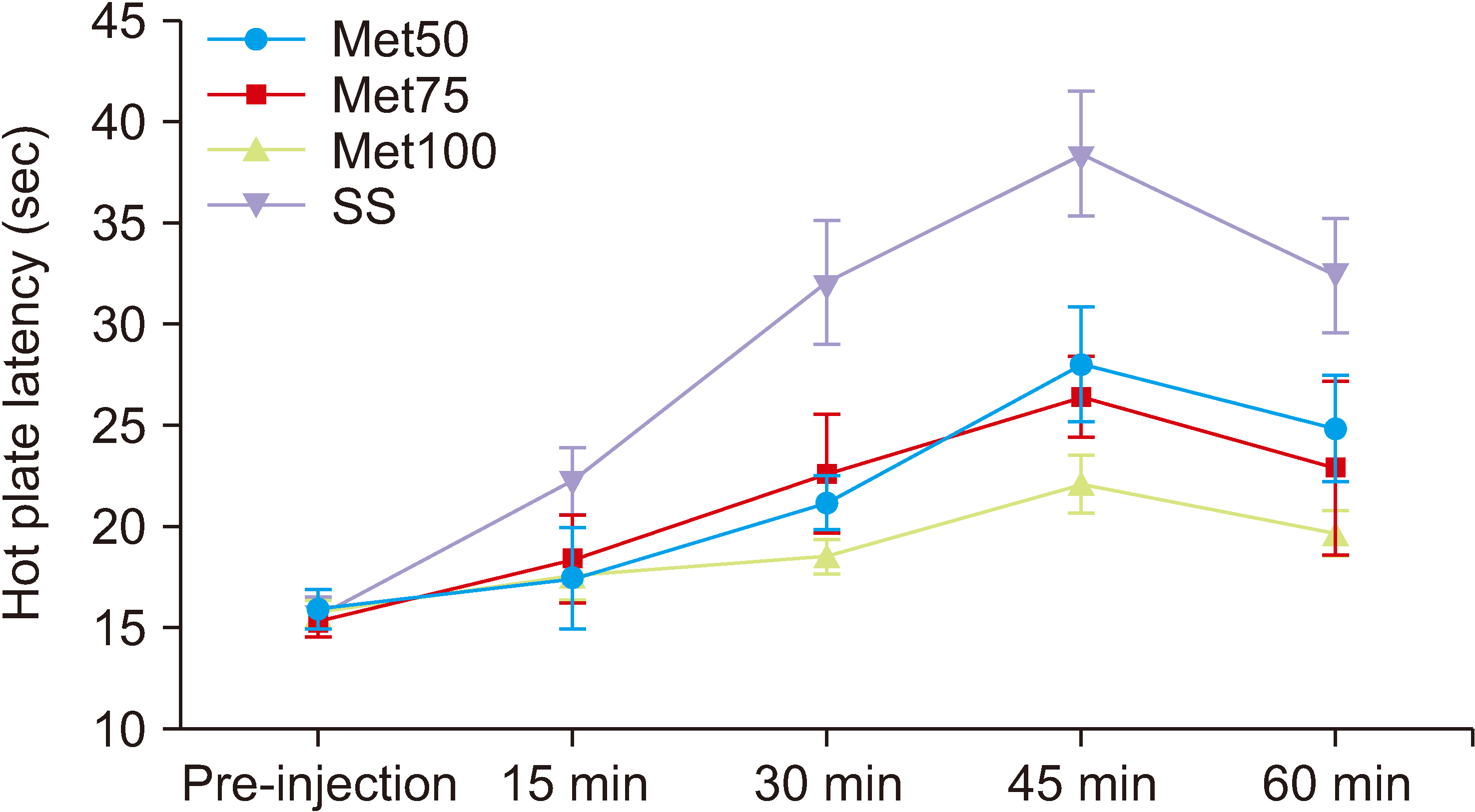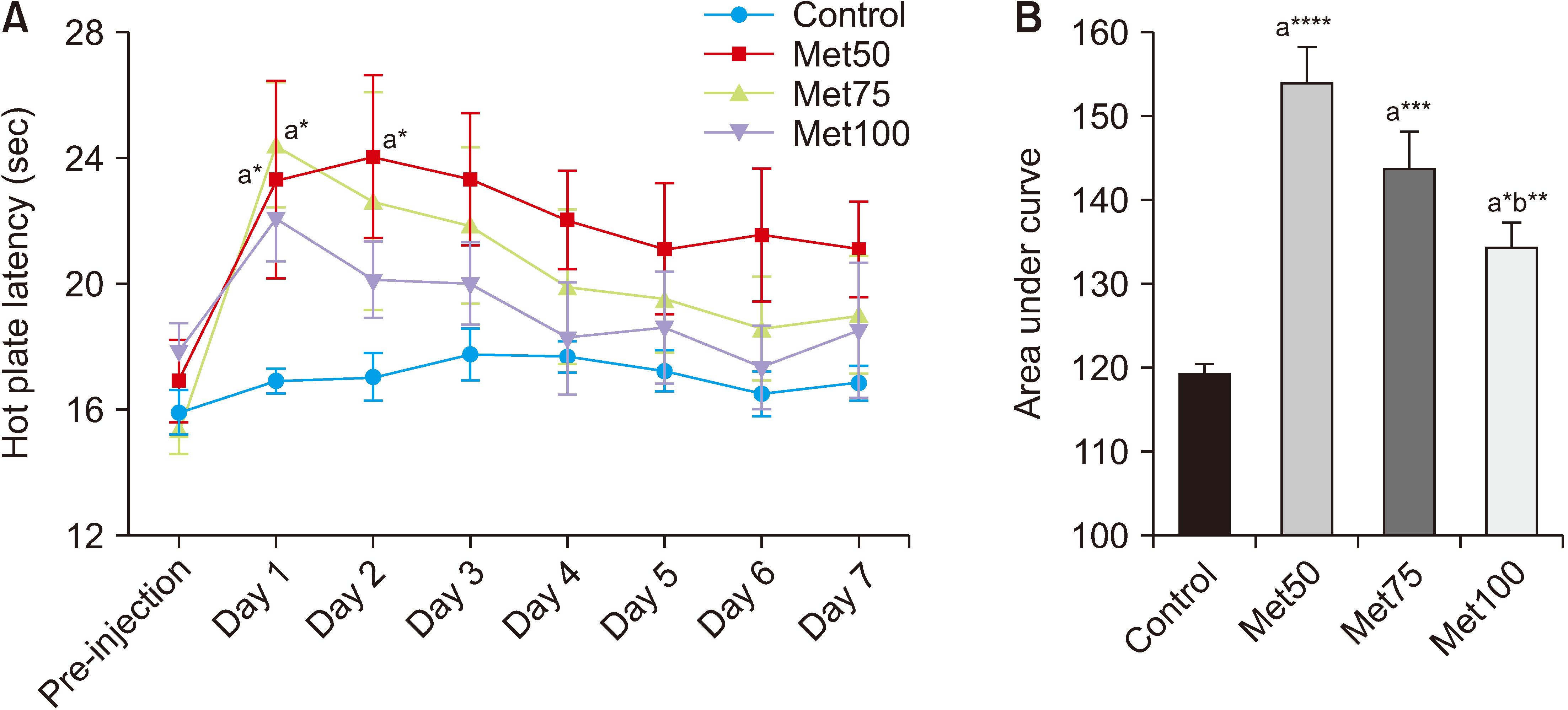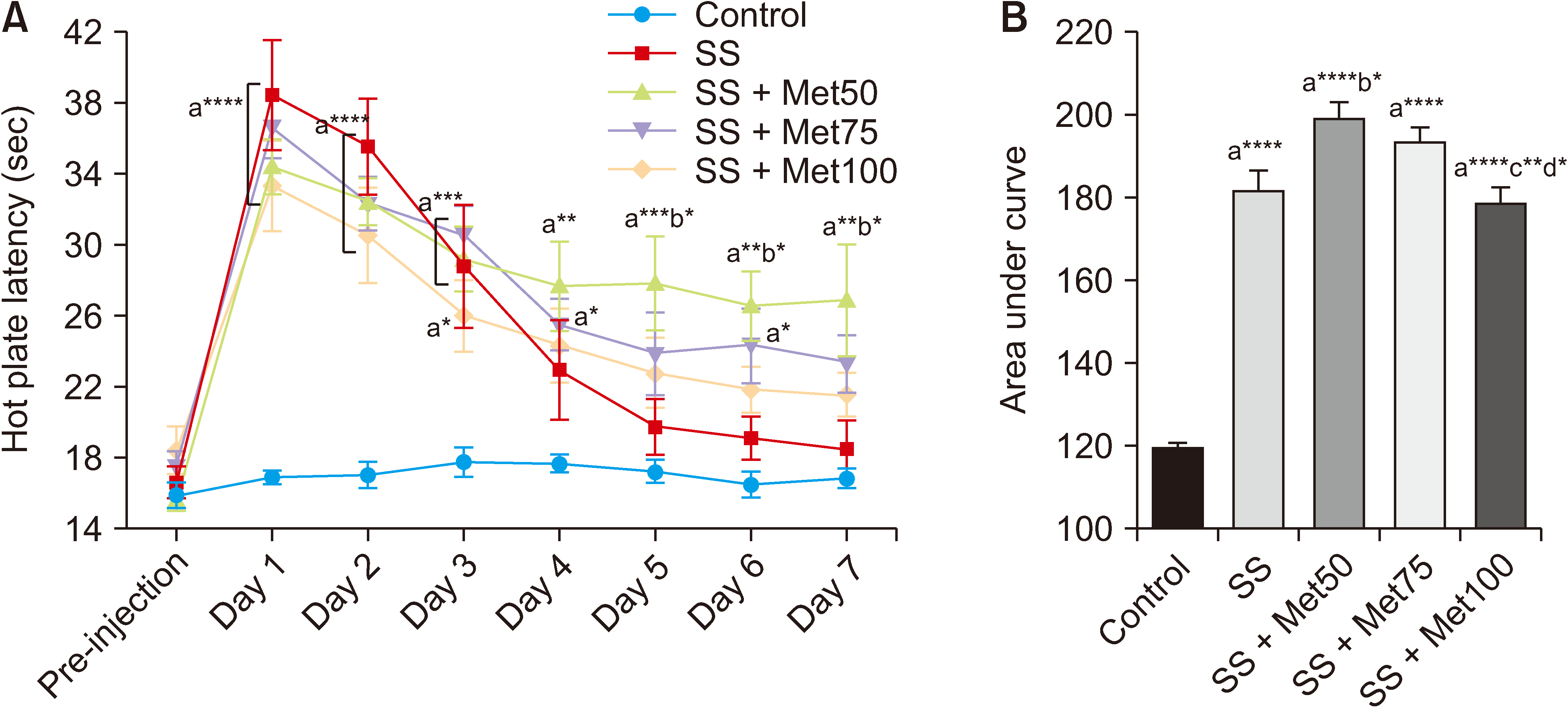1. Pan Y, Sun X, Jiang L, Hu L, Kong H, Han Y, et al. 2016; Metformin reduces morphine tolerance by inhibiting microglial-mediated neuroinflammation. J Neuroinflammation. 13:294. DOI:
10.1186/s12974-016-0754-9. PMID:
27855689. PMCID:
PMC5114746.
2. Déciga-Campos M, López UG, Reval MI, López-Muñoz FJ. 2003; Enhancement of antinociception by co-administration of an opioid drug (morphine) and a preferential cyclooxygenase-2 inhibitor (rofecoxib) in rats. Eur J Pharmacol. 460:99–107. DOI:
10.1016/S0014-2999(02)02920-5. PMID:
12559369.

4. Owoyele BV, Bakare AO, Olaseinde OF, Ochu MJ, Yusuff AM, Ekebafe F, et al. 2022; Corrigendum: synergistic interaction between acetaminophen and L-carnosine improved neuropathic pain via NF-κB pathway and antioxidant properties in chronic constriction injury model. Korean J Pain. 35:488. Erratum for: Korean J Pain 2022; 35: 271. DOI:
10.3344/kjp.2022.35.4.488. PMID:
36175348. PMCID:
PMC9530685.

5. Pernia-Andrade AJ, Tortorici V, Vanegas H. 2004; Induction of opioid tolerance by lysine-acetylsalicylate in rats. Pain. 111:191–200. DOI:
10.1016/j.pain.2004.06.006. PMID:
15327823.

6. Wideman GL, Keffer M, Morris E, Doyle RT Jr, Jiang JG, Beaver WT. 1999; Analgesic efficacy of a combination of hydrocodone with ibuprofen in postoperative pain. Clin Pharmacol Ther. 65:66–76. DOI:
10.1016/S0009-9236(99)70123-2. PMID:
9951432.

7. Sunshine A, Olson NZ, O'Neill E, Ramos I, Doyle R. 1997; Analgesic efficacy of a hydrocodone with ibuprofen combination compared with ibuprofen alone for the treatment of acute postoperative pain. J Clin Pharmacol. 37:908–15. DOI:
10.1002/j.1552-4604.1997.tb04265.x. PMID:
9505982.

8. Christie MJ, Vaughan CW, Ingram SL. 1999; Opioids, NSAIDs and 5-lipoxygenase inhibitors act synergistically in brain via arachidonic acid metabolism. Inflamm Res. 48:1–4. DOI:
10.1007/s000110050367. PMID:
9987677.

9. Tsiklauri N, Gurtskaia G, Tsagareli M. 2008; Study of non-opioid analgesics tolerance in young and adult rats. Georgian Med News. 158:40–4.
10. Trujillo KA, Akil H. 1991; Opiate tolerance and dependence: recent findings and synthesis. New Biol. 3:915–23.
11. Bao W, Luo Y, Wang D, Li J, Wu X, Mei W. 2018; Sodium salicylate modulates inflammatory responses through AMP-activated protein kinase activation in LPS-stimulated THP-1 cells. J Cell Biochem. 119:850–60. DOI:
10.1002/jcb.26249. PMID:
28661045. PMCID:
PMC5724678.

13. Liu SN, Liu Q, Sun SJ, Hou SC, Wang Y, Shen ZF. 2014; [Metformin ameliorates β-cell dysfunction by regulating inflammation production, ion and hormone homeostasis of pancreas in diabetic KKAy mice]. Yao Xue Xue Bao. 49:1554–62. Chinese.
14. Zhou C, Sun R, Zhuang S, Sun C, Jiang Y, Cui Y, et al. 2016; Metformin prevents cerebellar granule neurons against glutamate-induced neurotoxicity. Brain Res Bull. 121:241–5. DOI:
10.1016/j.brainresbull.2016.02.009. PMID:
26876755.

15. Bonnefont-Rousselot D, Raji B, Walrand S, Gardès-Albert M, Jore D, Legrand A, Peynet J, et al. 2003; An intracellular modulation of free radical production could contribute to the beneficial effects of metformin towards oxidative stress. Metabolism. 52:586–9. DOI:
10.1053/meta.2003.50093. PMID:
12759888.

16. Bułdak Ł, Machnik G, Bułdak RJ, Łabuzek K, Bołdys A, Okopień B. 2016; Exenatide and metformin express their anti-inflammatory effects on human monocytes/macrophages by the attenuation of MAPKs and NFκB signaling. Naunyn Schmiedebergs Arch Pharmacol. 389:1103–15. DOI:
10.1007/s00210-016-1277-8. PMID:
27424158.

17. Houser VP, Paré WP. 1973; Analgesic potency of sodium salicylate, indomethacin, and chlordiazepoxide as measured by the spatial preference technique in the rat. Psychopharmacologia. 32:121–31. DOI:
10.1007/BF00428683. PMID:
4753530.

18. Sadegh M, Fathollahi Y, Naghdi N, Semnanian S. 2013; Morphine deteriorates spatial memory in sodium salicylate treated rats. Eur J Pharmacol. 704:1–6. DOI:
10.1016/j.ejphar.2013.02.017. PMID:
23461854.

19. Afshari K, Dehdashtian A, Haddadi NS, Haj-Mirzaian A, Iranmehr A, Ebrahimi MA, et al. 2018; Anti-inflammatory effects of Metformin improve the neuropathic pain and locomotor activity in spinal cord injured rats: introduction of an alternative therapy. Spinal Cord. 56:1032–41. DOI:
10.1038/s41393-018-0168-x. PMID:
29959433.

20. Pecikoza UB, Tomić MA, Micov AM, Stepanović-Petrović RM. 2017; Metformin synergizes with conventional and adjuvant analgesic drugs to reduce inflammatory hyperalgesia in rats. Anesth Analg. 124:1317–29. DOI:
10.1213/ANE.0000000000001561. PMID:
27669556.

21. Tsiklauri N, Pirkulashvili N, Nozadze I, Nebieridze M, Gurtskaia G, Abzianidze E, et al. 2018; Antinociceptive tolerance to NSAIDs in the anterior cingulate cortex is mediated via endogenous opioid mechanism. BMC Pharmacol Toxicol. 19:2. DOI:
10.1186/s40360-017-0193-y. PMID:
29304875. PMCID:
PMC5756434.

22. Giglio CA, Defino HL, Del Bel EA. da-Silva CA. de-Souza AS. 2006; Behavioral and physiological methods for early quantitative assessment of spinal cord injury and prognosis in rats. Braz J Med Biol Res. 39:1613–23. DOI:
10.1590/S0100-879X2006001200013. PMID:
17160271.

24. Asiedu MN, Han C, Dib-Hajj SD, Waxman SG, Price TJ, Dussor G. 2017; The AMPK activator A769662 blocks voltage-gated sodium channels: discovery of a novel pharmacophore with potential utility for analgesic development. PLoS One. 12:e0169882. DOI:
10.1371/journal.pone.0169882. PMID:
28118359. PMCID:
PMC5261566.

25. Baeza-Flores GDC, Guzmán-Priego CG, Parra-Flores LI, Murbartián J, Torres-López JE, Granados-Soto V. 2020; Metformin: a prospective alternative for the treatment of chronic pain. Front Pharmacol. 11:558474. DOI:
10.3389/fphar.2020.558474. PMID:
33178015. PMCID:
PMC7538784.

26. Russe OQ, Möser CV, Kynast KL, King TS, Stephan H, Geisslinger G, et al. 2013; Activation of the AMP-activated protein kinase reduces inflammatory nociception. J Pain. 14:1330–40. DOI:
10.1016/j.jpain.2013.05.012. PMID:
23916727.

27. Bullón P, Alcocer-Gómez E, Carrión AM, Marín-Aguilar F, Garrido-Maraver J, Román-Malo L, et al. 2016; AMPK phosphorylation modulates pain by activation of NLRP3 inflammasome. Antioxid Redox Signal. 24:157–70. DOI:
10.1089/ars.2014.6120. PMID:
26132721. PMCID:
PMC4742979.

28. Augusto PSA, Braga AV, Rodrigues FF, Morais MI, Dutra MMGB, Batista CRA, et al. 2019; Metformin antinociceptive effect in models of nociceptive and neuropathic pain is partially mediated by activation of opioidergic mechanisms. Eur J Pharmacol. 858:172497. DOI:
10.1016/j.ejphar.2019.172497. PMID:
31238066.

30. Burian M, Geisslinger G. 2005; COX-dependent mechanisms involved in the antinociceptive action of NSAIDs at central and peripheral sites. Pharmacol Ther. 107:139–54. DOI:
10.1016/j.pharmthera.2005.02.004. PMID:
15993252.

31. Vanegas H, Schaible HG. 2001; Prostaglandins and cyclooxygenases [correction of cycloxygenases] in the spinal cord. Prog Neurobiol. 64:327–63. Erratum in: Prog Neurobiol 2001; 65: 609. DOI:
10.1016/S0301-0082(01)00026-0.
32. Vanegas H, Tortorici V. 2002; Opioidergic effects of nonopioid analgesics on the central nervous system. Cell Mol Neurobiol. 22:655–61. DOI:
10.1023/A:1021896622089. PMID:
12585685.
33. Elberry AA, Sharkawi SMZ, Wahba MR. 2019; Antinociceptive and anti-inflammatory effects of N-acetylcysteine and verapamil in Wistar rats. Korean J Pain. 32:256–63. DOI:
10.3344/kjp.2019.32.4.256. PMID:
31569917. PMCID:
PMC6813896.

34. Tsiklauri N, Viatchenko-Karpinski V, Voitenko N, Tsagareli MG. 2010; Non-opioid tolerance in juvenile and adult rats. Eur J Pharmacol. 629:68–72. DOI:
10.1016/j.ejphar.2009.12.016. PMID:
20035744.

35. Shirooie S, Esmaeili J, Sureda A, Esmaeili N, Mirzaee Saffari P, Yousefi-Manesh H, et al. 2020; Evaluation of the effects of metformin administration on morphine tolerance in mice. Neurosci Lett. 716:134638. DOI:
10.1016/j.neulet.2019.134638. PMID:
31756370.
37. Lisi L, Aceto P, Navarra P, Dello Russo C. 2015; mTOR kinase: a possible pharmacological target in the management of chronic pain. Biomed Res Int. 2015:394257. DOI:
10.1155/2015/394257. PMID:
25685786. PMCID:
PMC4313067.








 PDF
PDF Citation
Citation Print
Print



 XML Download
XML Download